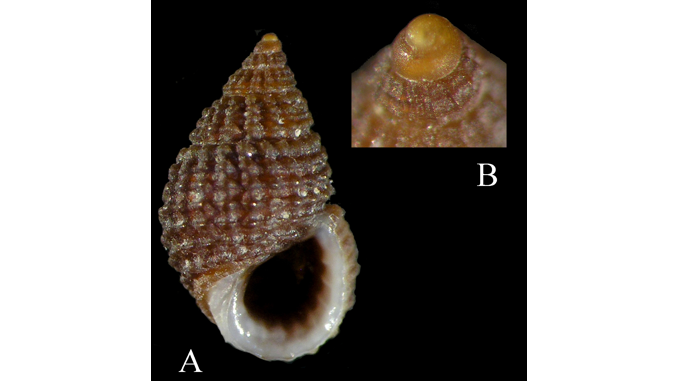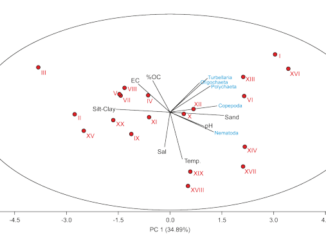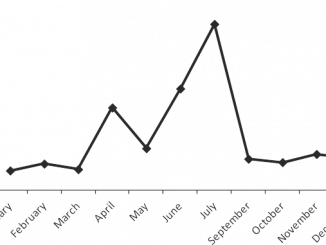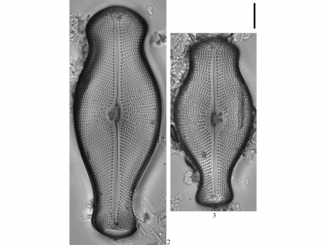
Paper category: Original research paper
Corresponding author: Banu Bitlis (banubitlis@yahoo.com)
DOI: 10.2478/ohs-2019-0016
Received: 02/07/2018
Accepted: 06/11/2018
Full text: here
Citation (APA style): Bitlis, B. (2019). Mollusk fauna associated with Cystoseira barbata (Stockhouse) C. Agardh, 1820 in the Sea of Marmara (Turkey). Oceanological and Hydrobiological Studies, 48(2), pp. 174-183. Retrieved 3 Oct. 2019, from doi:10.1515/ohs-2019-0016
Abstract
Mollusk species associated with Cystoseira barbata were examined in the Sea of Marmara in 2012 at 14 sampling sites with a depth ranging from 0.2 to 0.5 m. A total of 18 468 specimens belonging to three classes (Polyplacophora, Gastropoda and Bivalvia) and 30 species were identified. Alvania mamillata Risso, 1826 is a new record for the marine mollusk fauna of the Sea of Marmara. The number of species at the sampling sites varied from 2 to 11 (400 cm−2), the density ranged between 758 and 63 083 ind. m−2, and wet weight between 0.4 and 34.3 g m−2. Gastropoda were the richest class, represented by 22 species and 7611 individuals. The families Rissoidae, Mytilidae and Pyramidellidae were represented by the largest number of species. The most dominant mollusk species in C. barbata facies were Mytilaster minimus (Poli, 1795) (37.77%), Rissoa splendida Eichwald, 1830 (27.20%), Mytilaster lineatus (Gmelin, 1791) (18.69%) and Bittium reticulatum (da Costa, 1778) (6.89%). However, the mollusks R. splendida (86%), M. lineatus (71%), M. minimus (69%) and Steromphala adansonii (Payraudeau, 1826) (67%) were characterized by the highest values of the frequency index. Canonical correspondence analysis showed that the main factors affecting the assemblages of mollusks were the content of total nitrogen, the maximum thallus height, algal wet weight and temperature.
Banu Bitlis
References
Aartsen, J.J. van & Kinzelbach, R. (1990). Marine molluscs from the Iztuzu beach near Dalyan (Mediterranean coast of Turkey). Zool. Middle East 4(1): 103–112.
Açık, Ş. (2017). Distribution of Sipunculans along the Aegean and Levantine coasts of Turkey. Cah. Biol. Mar. 58: 317–330. DOI: 10.21411/CBM.A.BE8452C8.
Albayrak, S. & Balkıs, N. (1996a). Benthic prosobranch gastropods of the Bosphorus. Istanbul University Faculty of Science. The Journal of Biology 17–26.
Albayrak, S. & Balkıs, N. (1996b). Bivalve fauna of the Bosphorus. Istanbul University Faculty of Science. The Journal of Biology 59: 1–15.
Albayrak, S., Balkıs, H. & Balkıs, N. (2004). Bivalvia (Mollusca) fauna of the Sea of Marmara. Acta Adriat. 45: 9–26.
Artüz, M.L., Tunçer, S. & Poursanidis, D. (2018). Contributions to the biodiversity of sea slugs and shelled relatives of the Sea of Marmara (Mollusca: Gastropoda). Cah. Biol. Mar. 59: 267–276. DOI: 10.21411/CBM.A.88763B1A.
Aslan-Cihangir, H. & Ovalis, P. (2013). Seasonal variations and structure of the molluscan assemblage in the Canakkale Strait (Turkey). Acta Zool. Bulgar. 65: 233–250.
Bellan-Santini, D. (1969). Etude floristuque et faunistique de quelques peuplements infralittoraux de subsrat rocheus. Recueil des Travaux de la Station Marine d’Endoume 26(41): 237–298.
Berov, D., Deyanova, D., Georgieva, I., Gyosheva, B. & Hiebaum, G. (2012). Cystoseira sp. dominated macroalgal communities in the SW Black Sea (Burgas Bay, Bulgaria). Current state and possible long-term effects of eutrophication. Biologie 65(6): 821–830.
Beşiktepe, S.T., Sur, H.I. Özsoy, E., Latif, M.A., Orguz, T. et al. (1994). The circulation and hydrography of the Marmara Sea. Prog. Oceanogr. 34(4): 285–334.
Bitlis, B. & Öztürk, B. (2017). The genus Alvania (Gastropoda: Rissoidae) along the Turkish Aegean coast with the description of a new species. Sci. Mar. 81(3): 395–411. DOI: 10.3989/scimar.04566.14A.
Chemello, R. & Milazzo, M. (2002). Effect of algal architecture on associated fauna: some evidence from phytal molluscs. Mar. Biol. 140(5): 981–990. DOI: 10.1007/s002227-002-0777-x.
Chiarore, A., Fioretti, S., Meccariello, A., Saccone, G. & Patti, F.P. (2017). Molluscs community associated with the brown algae of the genus Cystoseira in the Gulf of Naples (South Tyrrhenian Sea). bioRxiv 160200. DOI: 10.1101/160200.
Colombo, A. (1885). Raccolte Zoologiche Eseguite dal R. Piroscafo Washington Nella Campagna Abissale Talossografica dell’anno 1885. Riviste Marittima 18: 22–53.
Çulha, M., Bat, L., Türk-Çulha, S. & Çelik, M.Y. (2010). Benthic mollusk composition of some facies in the upper-infralittoral zone of the southern Black Sea, Turkey. Turk. J. Zool. 34: 523–532. DOI: 10.3906/zoo-0806-12.
Demir, M. (2003). Shells of Mollusca collected from the seas of Turkey. Turk. J. Zool. 27: 101–140.
Doğan, A., Öztürk, B., Bitlis-Bakır, B. & Türkçü, N. (2016). Soft bottom Molluscan assemlages of the Bathyal zone of the Sea of Marmara. Medit. Mar. Sci. 17(3): 678–691. DOI: 10.12681/mms.1748.
Ergen, Z. & Çınar, M.E. (1994). Qualitative and Quantitative Investigations on the Cystoseira Facies of the Aegean Sea. XII. National Biology Congress, 6–8 July 1994, (pp. 138–149). Edirne, Turkey.
Forsskål, P. (1775). Descriptiones animalium avium, amphibiorum, piscium, insectorum, vermium; quae in itinere orientali observavit Petrus Forskal. Post mortem auctoris edidit Carsten Niebuhr Adjuncta est materia medica Kahirina atqus tabula maris rubri geographica. Copenhagen, 164 p.
Gözler, A., Kopuz, U. & Ağırbaş, E. (2010). Seasonal changes of invertebrate fauna associated with Cystoseira barbata facies of Southeastern Black Sea coast. African Journal of Biotechnology 9(51): 8852–8859. DOI: 10.5897/AJB.10454.
Kocataş, A. (1978). İzmir Körfezi Kayalık Sahillerinin Bentik Formları Üzerinde Kalitatif ve Kantitatif Araştırmalar. Ege Üniversitesi Fen Fakültesi Monografiler 12: 1–93.
Kurt Şahin, G., Dağlı, E. & Sezgin, M. (2017). Spatial and temporal variations of soft bottom polychaetes of Sinop Peninsula (southern Black Sea) with new records. Turk. J. Zool. 41: 89–101. DOI: 10.3906/zoo-1510-15.
Marion, A.F. (1898). Notes sur la faune des Dardanelles et du Bosphore. Annual Museum History Natural Marseille (ser: 2) Bull Notes Zool. Géol. Paléontol. 1: 163–182.
Oberling, J.J. (1969–1971). On the littoral Mollusca of the Sea of Marmara. Separatdruck Aus Dem jahrbuch Des Naturhistoristorischen Museums Des Stadt 4: 183–218.
Orfanidis, S., Panayotidis, P. & Stamatis, N. (2001). Ecological evaluation of transitional and coastal waters: A marine benthic macrophytes-based model. Medit. Mar. Sci. 2(2): 45–66. DOI: 10.12681/mms.266.
Ostroumoff, A. (1896). Otchet o dragirovkah i planktonniyh ulovaht ekspeditsia “Selyanika”. Bulletin de l’Academie Imperiale des Sciences de St. Petersbourg 5: 33–92.
Özsoy, E., Latif, M.A., Tuğrul, S. & Ünlüata, U. (1995). Exchanges with the Mediterranean fluxes, and boundary mixing processes in the Black Sea. Bulletin de I’Institut Oceanographique. Monaco, 15: 1–25.
Öztürk, B., Doğan, A., Bitlis-Bakır, B. & Salman, A. (2014). Marine Molluscs of the Turkish Coasts: An Updated Checklist. Turk. J. Zool. 38: 832–879. DOI: 10.3906/zoo-1405-78.
Pallary, P. (1917). Mollusques marins des Dardanelles colligés par M. Claude Bravard. J. Conch. 63: 142–147.
Parsons, T.R., Maita, Y. & Lalli, C.M. (1984). A manual of chemical and biological Methods for Seawater Analysis. Pergamon Press, New York, 173 p.
Pielou, E.C. (1975). Ecological diversity. John Wiley Interscience Publ. London.
Pitacco, V., Orlando-Bonaca, M., Mavrič, B., Popović, A. & Lipej, L. (2014). Mollusc fauna associated with the Cystoseira algal associations in the Gulf of Trieste (Northern Adriatic Sea). Medit. Mar. Sci. 15(2): 225–238. DOI: 10.12681/mms.466.
Risso, A. (1826). Histoire naturelle des principales productions de l’Europe Méridionale et particulièrement de celles des environs de Nice et des Alpes Maritimes. Vol. 4. Paris, Levrault, 439 pp.
Russo, A.R. (1997). Epifauna living on sublittoral seaweeds around Cyprus. Hydrobiologia 344(1/2/3): 169–179.
Sánchez-Moyano, J., Estacio, F., Garcia-Adiego, E. & Garcia-Gómez, J. (2000). The molluscan epifauna of the alga Halopteris scoparia in Southern Spain as a bioindicator of coastal environmental conditions. J. Mollus. Stud. 66(4): 431–448.
Shannon, C.E. & Weaver, V. (1949). A mathematical theory of communication. Univ. Press. Illinois, Urbana.
Soyer, J. (1970). Bionomie benthique du plateau continental de la cote catalana Française. III. Les Peuplements de Copepodes Harpacticodies (Crustacea). Vie Milieu. 21: 377–511.
Sturany, R (1895). Bestimmungsliste der von Herrn Dr Konrad Natterer auf S.M.Schiff “Taurus” im Marmara-Meere Gedredschten mollusken. Denkschriften der mathem-naturw CI 62: 119–121.
Tselepides, A., Papadopoulou, N., Podoras, D., Plaiti, W. & Koutsoubas, D. (2000). Macrobenthic community structure over the continental margin of Crete (South Aegean Sea, NE Mediterranean). Prog. Oceanogr. 46(2–4): 401–428.
WoRMS Editorial Board (2018). World Register of Marine Species. Retrieved July 02, 2018, from http://www.marinespecies.org at VLIZ. doi:10.14284/170
Zenetos, A. & Aartsen J.J. van. (1995). The deep sea Molluscan Fauna of the S.E. Aegean Sea and its relation to the neighbouring faunas. Boll. Malacol. 30: 253–268.




Bądź pierwszy, który skomentuje ten wpis